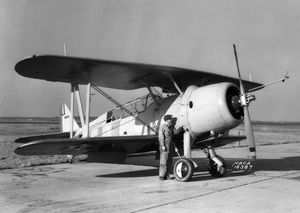
Vought XSB3U
The Vought XSB3U was an American biplane scout bomber developed by Vought-Sikorsky for the United States Navy during the 1930s. Developed as an alternative to the SB2U Vindicator monoplane, the aircraft proved unsatisfactory to the Navy in comparison, and development was not pursued.
Design and development
In late 1934, the U.S. Navy's Bureau of Aeronautics (BuAer) issued a specification for new scout bomber and torpedo bomber designs. Eight companies submitted ten designs in response, evenly split between monoplanes and biplanes.
Exemplifying the Bureau of Aeronautics' reluctance to fully embrace the monoplane configuration for carrier-based aircraft, the XSB3U-1 was proposed as a more conventional alternative to Vought's XSB2U-1, which was designed as a modern monoplane. The XSB3U was modified from the last production SBU Corsair, using essentially the same airframe, including a fully enclosed cockpit, and Pratt & Whitney R-1535 radial engine, but with a more streamlined surface and cowling. In addition, the XSB3U had fully retractable landing gear.
Podcasts:

